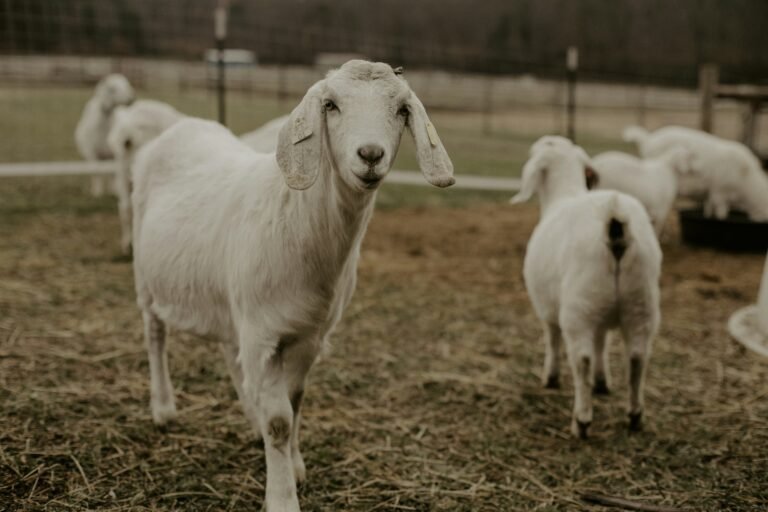Why Do Goat Horns Peel? Top 5 Most Common Reasons

Here’s a table that represents the common reasons for goat horns peeling and their treatments:
| Common Reasons for Goat Horn Peeling | Preventions and Treatments |
|---|---|
| Nutrient Deficiency (Protein, Salt, Magnesium, Calcium, Phosphorus) | Feed goats a balanced ration with protein-rich feeds like alfalfa, leafy grass, and supplements containing vitamins K, C, A, D, and Biotin. |
| Excessive Dryness (Weather, Lack of Hydration) | Ensure goats have unlimited access to fresh water and apply veterinarian-approved balm if needed. |
| Physical Damage (Headbutting, Cracks, Playful or Aggressive Behavior) | Treat mild injuries by bandaging the area. For severe injuries, consult a veterinarian. Reduce physical damage by introducing toys or distractions. |
| New Growth (Peeling During Growth Spurts) | Maintain a balanced diet and proper hydration. Consult a veterinarian if excessive peeling occurs. |
| Hydration (Lack of Water) | Provide unlimited access to clean water and ensure proper hydration during hot weather. |
It’s not uncommon for goat owners to notice peeling or flaking on their animal’s horns. While this can cause concern, it’s usually a manageable issue, often linked to environmental or dietary factors. As a cattle hoof trimmer, I’ve seen this phenomenon and found that it’s rarely a major health issue, but one that still needs to be addressed to ensure the optimal condition of the goat’s health. We’ll explore the five most common reasons why goat horns peel and how to handle each situation, from nutrient deficiency to physical damage and new growth.
1. Nutritional Deficiencies
One of the leading causes of goat horn peeling is nutritional deficiency. Horns are primarily made of keratin, the same protein found in human hair and fingernails. A protein deficiency weakens the structural integrity of the horns, making them more prone to peeling and flaking. Essential micronutrients such as salt, magnesium, calcium, and phosphorus also play critical roles in the health of the horn. Without these, the horn will weaken over time.
Treatment
To correct this issue, ensure that your goat is consuming a balanced ration rich in protein. Adding high-protein feeds like alfalfa and leafy grass, as well as supplements with vitamins K, C, A, D, can strengthen the horns. A nutritionist or a visit to the feed mill can help tailor a mineral package to meet your goat’s needs. Also, consider Biotin for improved hoof development, with a recommended daily rate of 10 mg for pregnant goats.
2. Moisture and Hydration
Lack of hydration is often overlooked but can be a critical factor in goat horn peeling. Without adequate moisture, the horns become dry and brittle, making them more susceptible to flaking. Ensuring your goat has unlimited access to clean water is one of the simplest ways to maintain horn health.
Treatment
Keep your goats hydrated by offering plenty of water daily, especially during hot weather. Make sure they have a shaded area to rest during the hottest part of the day to avoid heat strokes and excessive dryness. Proper hydration will help maintain moisture levels in the horns, preventing peeling due to dehydration.

3. New Growth
During periods of new growth, it’s natural for goat horns to peel slightly. Unlike exoskeletons that animals shed, goat horns don’t fully shed. However, as the horns grow in size, their movement can cause peeling, especially around the ends. This is generally not a cause for concern, though it can look alarming to new goat owners.
Treatment
There’s little you can do to prevent new growth-related peeling, but it’s essential to maintain your goat’s health by providing a rich, balanced diet and sufficient hydration. If the peeling seems excessive, consult with your veterinarian to rule out other issues, but rest assured that this type of peeling usually stops once the goat reaches maturity.
4. Physical Damage
Physical damage is a more straightforward cause of goat horn peeling. Goats are active animals, often engaging in behaviors like headbutting, which can lead to cracks or peeling in their horns. This damage could be playful or aggressive, but it weakens the horn’s structure and leads to flaking.
Treatment
If the damage is mild, you can treat it by carefully bandaging the affected area. If the injury is severe, contact your veterinarian for further guidance. After treating the injury, the peeling should lessen as the horn heals. To prevent repeated damage, introduce toys or brushes to distract your goats, reducing their inclination to engage in damaging behaviors out of boredom.
5. Excessive Dryness
Excessive dryness is another common reason for goat horn peeling. Since goat horns are made from keratin, they can be affected by weather changes and hydration just like human fingernails and skin. Insufficient moisture makes the horns brittle, leading to flakes and peeling. Weather extremes, poor hydration, and dry conditions can all contribute to this problem.
Treatment
To combat dryness, make sure your goats have unlimited access to fresh water and are kept in a well-ventilated, shaded environment during hot weather. A specially designed balm can be applied, but consult your veterinarian first to avoid products that could trap body heat and cause heat strokes.
Summary: Why Do Goat Horns Peel
In summary, peeling goat horns are often a manageable issue. Whether due to nutritional deficiencies, excessive dryness, physical damage, or new growth, it’s essential to maintain your goat’s health by ensuring a well-rounded diet, proper hydration, and addressing any physical injuries. If the problem persists, it’s always best to seek a professional opinion from a veterinarian. Taking these measures will ensure the structural integrity of your goat’s horns and their overall well-being.
Table of Contents
RELATED POSTS:
Web Crew © 2024 All Rights Reserved.

